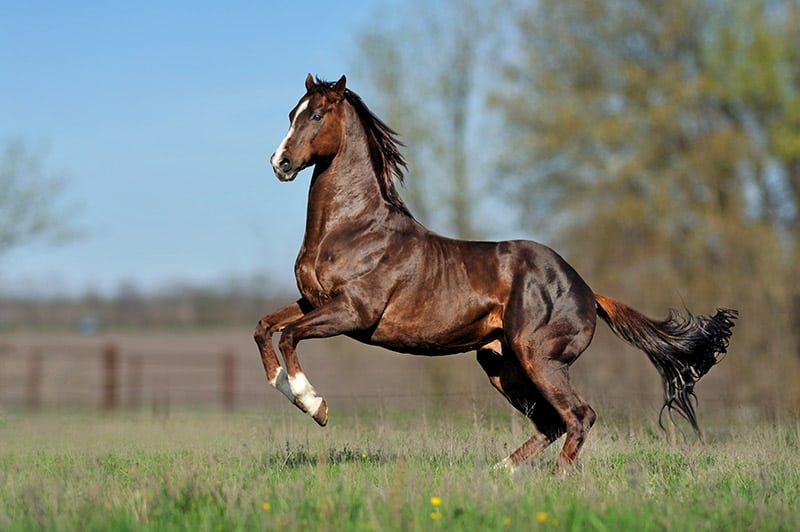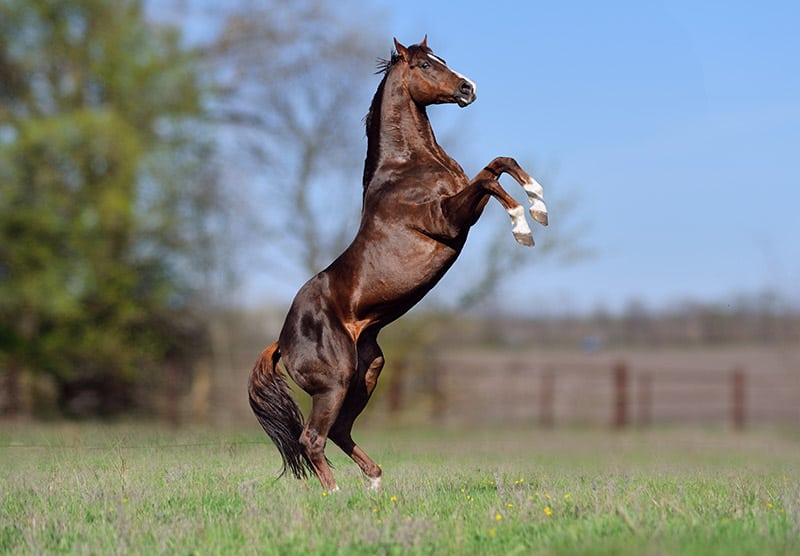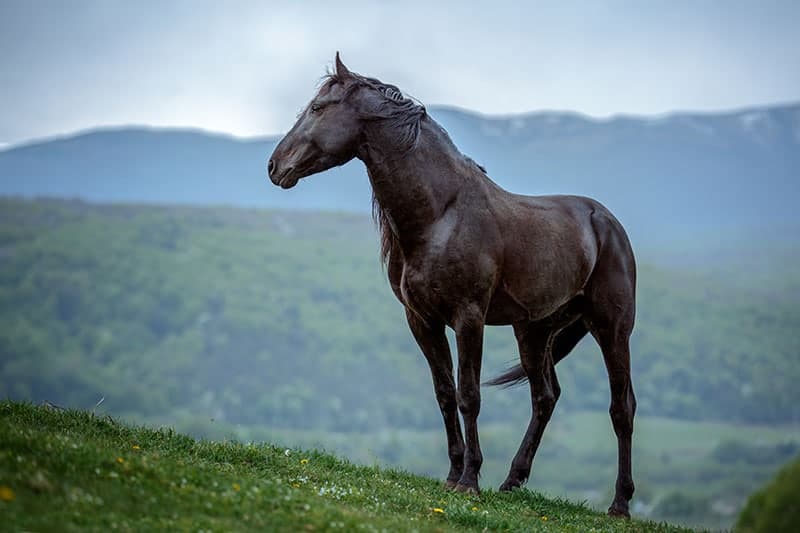The Thoroughbred is the fastest horse in the world and dominates the horse racing industry!
The Thoroughbred evolved in Britain in the 17th and 18th centuries, due to an interest in racing. The Thoroughbred pedigree can be traced back to the bloodlines of the three key Arabian stallions, none of which ever raced. Most Thoroughbred genes are derived from only 31 original ancestors, and all descend from these three stallions.
Thoroughbreds are extremely athletic and energetic. They are the most popular breed for sport horse competition and they dominate the horse racing industry. They are also top competitors in show jumping, dressage, and eventing. They tend to be “hot” horses, meaning they are energetic. They can be a lot to handle, so they are generally not good horses for beginners.
The Thoroughbreds are long and sleek, with long legs. They have a fine chiseled head and a straight profile, lacking the Arabian dish of their ancestors. Their bloodlines have been crossed with many other warmbloods to create new breeds as well as improve existing ones. Some of the breeds they have influenced include the Quarter Horse, Standardbred, and the Anglo-Arabian horse.
Horse Breeds
The Thoroughbred is a light horse breed. These light horses are also referred to as a warmblood or ‘hot-blooded’ horse. Light horse breeds generally weigh under 1,500 pounds. They are typically used as riding horses for leisure and trail riding. Being agile and swift, many are also used on the racetrack, in the show ring, and for work on the ranch.
Light horses are grouped in a couple of different ways, one being the continent or country where they originated from. They are also grouped according to training, classified as either a stock type, hunter type (sport horse), saddle type, or ‘other’. A body type is generally attributed to each class, with the ‘other’ classification being a bit of an odd ball. It includes those that are color breeds or those that may fit a body type of one of the training classes, but not be used for that type of training. The ‘other’ types can also include those that may fit into more than one of the type groups.
The horse class the Thoroughbred fits into is the ‘Hunter’ type class.
2012 Kentucky Derby
Scientific Classification
| Kingdom: | Animalia |
| Phylum: | Chordata |
| Class: | Mammalia |
| Order: | Perissodactyla |
| Family: | Equidae |
| Genus: | Equus |
| Species: | caballus |
Horse Backgrounds
The Thoroughbred evolved in Britain in the 17th and 18th centuries where there was a strong interest in horse racing. The British had been breeding ‘running horses’ for some time and King Henry VIII founded the first royal racing stables.
The Thoroughbred breed has three founding Arabian stallions, none of whom ever raced! These three principle Thoroughbred pedigree bloodlines include:
- Byerly Turk – The Byerly Turk stood stud in County Durham and founded the first of the principle bloodlines.
- Darley Arabian – The Darley Arabian was bought in Syria and brought to the owner’s home in East Yorkshire. He was mated with the mare Betty Leeds and produced the first great racehorse, Flying Childers, and Bartlett’s Childers whose descendent Eclipse founded the second bloodline.
- Godolphin Arabian – The Godolphin Arabian was brought to England in 1728 by Lord Godolphin of Cambridgeshire. He was grandsire to Matchem who leads the third line.
All modern Thoroughbreds descend from these three stallions in the male line and 81% of Thoroughbred genes are derived from 31 original ancestors.
Description
Thoroughbreds are usually around 16 hands and the principal colors are brown, bay, chestnut, and black. They have a fine head with a straight profile that does not display the Arabian dish of their ancestors. They are long and sleek, with long legs. They key to their swiftness is the long distance between the hind hip and hock that allows for maximum thrust when galloping and the depth of the girth that allows for maximum lung expansion.
The modern Thoroughbred is bred to mature at an early age because the prime racing years are at 2 and 3 years old. All horses who run in the Triple Crown, composed of the Preakness, the Belmont, and the Kentucky Derby, are 3 year old Thoroughbreds.

Horse Care and Feeding
Thoroughbreds tend to have a fast metabolism so they require more feed for their size than other horses to keep at a good weight.
Horse Training and Activities
Thoroughbreds are extremely athletic and energetic, causing them to be the most popular breed for sport horse competition. They dominate the racing industry, and are top competitors in show jumping, dressage, and eventing. They tend to be “hot” horses, meaning they are energetic and can be a lot to handle so they are generally not good horses for beginners.
Common Health Problems
The Thoroughbred is physically tested to the utmost in horse racing. The results of this are high accident rates as well as other health problems. Some complications they are prone to are constipation, bleeding lungs, a small heart and hooves that are small for the size of their bodies, as well as low fertility.

Availability
The Thoroughbred is readily available throughout most of the world. The most expensive horses in the world are highly competitive Thoroughbreds, usually racehorses, but they can be found very reasonably priced for the common owner.
Thoroughbreds can be obtained at a low price at auctions for ex-racehorses, but these horses “off the track” need a lot of retraining for them to be good pleasure horses or competitors in other disciplines. They may also have injuries from racing at a young age.
If you are not prepared to retrain an “off the track” Thoroughbred, a Thoroughbred already trained for the discipline you want can be found reasonably through classified ads. Again they vary in price depending on training, bloodlines, and performance in competition.
Featured Image Credit: Orlova Yana, Shutterstock
